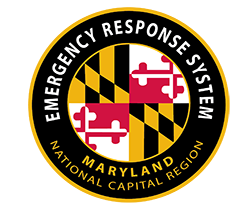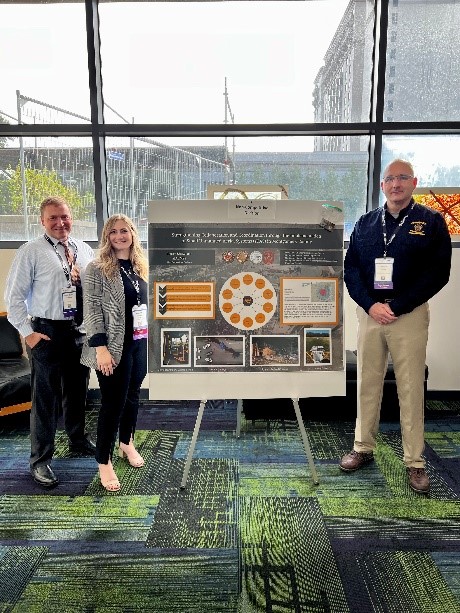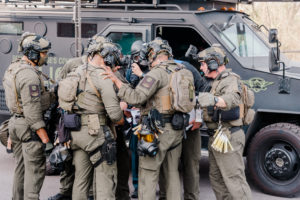The Public Access Trauma Care (PATC) program has expanded equipment distribution and training opportunities in Montgomery and Prince George’s Counties. These initiatives will increase the accessibility of medical equipment to allow individuals to render life-saving medical aid to injured patients.

Injuries that result in traumatic bleeding events can occur in various settings throughout communities. Automobile collisions, workplace accidents, construction mishaps, sports injuries, penetrating trauma, and other medical events can all lead to significant blood loss. A victim suffering from a major bleeding incident may potentially bleed out before the arrival of medical professionals. The Maryland-National Capital Region Emergency Response System (MDERS) developed the PATC program to provide civilians with the requisite knowledge, skills, abilities, and equipment to treat life-threatening injuries.

A PATC individual kit contains the medical supplies to treat major bleeding injuries, pneumothorax, and hypothermia. The kit contains a Combat-Application-Tourniquet (C-A-T), emergency trauma dressing, compressed gauze, medical gloves, trauma shears, chest seals, a mylar blanket, a permanent marker, a mini duct tape roll, and an instruction card. Five kits and a patient movement device are placed in a durable bag located in an accessible cabinet.
MDERS has coordinated with regional partners on the installation and placement of these medical supplies throughout the Maryland-National Capital Region (MD-NCR). In the last year, PATC 5-pack kits have been placed in Montgomery College, Prince George’s County Public high schools, Prince George’s County government buildings, and University of Maryland Global Campus facilities. Planned installations will occur later this year in Montgomery County government buildings and at the Universities at Shady Grove. The totality of these distributions exceeds 1,000 PATC 5-pack kits provided to our regional partners to create an immediate medical response capability to treat time-sensitive injuries.

In conjunction with the allocation of PATC 5-pack kits, MDERS has developed and procured training materials to educate the public to identify and treat medical emergencies. Five training videos were created to show viewers how to apply a chest seal, apply direct pressure, apply a tourniquet, maneuver a victim into the recover position, and pack a wound. A training presentation was created and provided to regional partners to allow for instruction on the basic medical steps needed to render proper aid to injured individuals. To support these trainings and promote hands-on practice with the PATC medical supplies, MDERS has established a training cache that can be utilized by our partners. MDERS has also acquired a training cache for Montgomery County Public Schools and will soon supply a training cache Prince George’s County Public Schools to teach students about the basic medical skills associated with the PATC program.
MDERS will continue investments in equipment and training for the PATC program will help promote prompt medical intervention by civilians to render life-saving medical aid. If you have any questions about the PATC program, please reach out via email to mders.org@maryland.gov.




 situational awareness if any hazards or risks occur while training. Upon working in four small groups, the Surgical Skills Lab provided participants with an opportunity to operate various medical equipment and execute intricate techniques on specimens donated to science and educational projects. This included the use of specialized instruments such as scalpels, forceps, and suture needles, as well as the proper application of suture materials and wound closure techniques. This is an essential skill for healthcare providers, as timely and proper wound management can prevent infection and promote healing.
situational awareness if any hazards or risks occur while training. Upon working in four small groups, the Surgical Skills Lab provided participants with an opportunity to operate various medical equipment and execute intricate techniques on specimens donated to science and educational projects. This included the use of specialized instruments such as scalpels, forceps, and suture needles, as well as the proper application of suture materials and wound closure techniques. This is an essential skill for healthcare providers, as timely and proper wound management can prevent infection and promote healing.
 Emergency Response System (MDERS), six MCPD representatives recently participated in a one-day, eight-hour virtual training session that addressed the legalities and challenges law enforcement endure when responding to suicidal subjects (National Tactical Officers Association, 2018). The training delivered by the National Tactical Officers Association (NTOA), introduces case law and varying viewpoints on policy and response decision-making as it relates to situations involving suicidal subjects.
Emergency Response System (MDERS), six MCPD representatives recently participated in a one-day, eight-hour virtual training session that addressed the legalities and challenges law enforcement endure when responding to suicidal subjects (National Tactical Officers Association, 2018). The training delivered by the National Tactical Officers Association (NTOA), introduces case law and varying viewpoints on policy and response decision-making as it relates to situations involving suicidal subjects.
 knowledge gained from Montgomery County pilots. The poster also addressed a wide array of relevant topics, findings, and real-world incidents for public safety agencies looking to grow their sUAS program. More importantly, attendees gained insights surrounding the operational concepts of the sUAS program that aid in response operations. This includes learning about the several advantages the sUAS program offers, which consists of enhancing situational awareness, information sharing, and search/rescue operations. The poster exhibited the stages of the sUAS program to highlight the required phases that must be satisfied to ensure an effective development and sustainment of the capability.
knowledge gained from Montgomery County pilots. The poster also addressed a wide array of relevant topics, findings, and real-world incidents for public safety agencies looking to grow their sUAS program. More importantly, attendees gained insights surrounding the operational concepts of the sUAS program that aid in response operations. This includes learning about the several advantages the sUAS program offers, which consists of enhancing situational awareness, information sharing, and search/rescue operations. The poster exhibited the stages of the sUAS program to highlight the required phases that must be satisfied to ensure an effective development and sustainment of the capability.

 Over the last several years, PGPD has expanded its sniper capability to ensure that a cadre of instructor-level officers is available on each shift to train EST members desiring to bolster their sniping skills. With the completion of the Positional Shooting Clinic, PGPD understands the need to build/enhance competency in key areas of positional shooting for long-range and precision sniping operations.
Over the last several years, PGPD has expanded its sniper capability to ensure that a cadre of instructor-level officers is available on each shift to train EST members desiring to bolster their sniping skills. With the completion of the Positional Shooting Clinic, PGPD understands the need to build/enhance competency in key areas of positional shooting for long-range and precision sniping operations.







 Health and Homeland Security (CHHS) and Montgomery County Office of Emergency Management and Homeland Security (OEMHS). This workshop allowed stakeholders to learn effective organizational preparedness and response capabilities, which could be applied to their agencies. In addition, MDERS continues to offer training opportunities providing its stakeholders with cutting-edge techniques to help protect their agency.
Health and Homeland Security (CHHS) and Montgomery County Office of Emergency Management and Homeland Security (OEMHS). This workshop allowed stakeholders to learn effective organizational preparedness and response capabilities, which could be applied to their agencies. In addition, MDERS continues to offer training opportunities providing its stakeholders with cutting-edge techniques to help protect their agency. MDERS has facilitated tabletop exercises and a full-scale active assailant exercise at Prince George’s County Police Department (PGPD) Training Facility and Firing Range. Additionally, MDERS worked with Prince George’s County Police Department and Montgomery County Police Department (MCPD) Special Operations Division’s (SOD) leadership to create a tabletop series to ensure a cohesive response in an interdisciplinary multi-jurisdictional incident.
MDERS has facilitated tabletop exercises and a full-scale active assailant exercise at Prince George’s County Police Department (PGPD) Training Facility and Firing Range. Additionally, MDERS worked with Prince George’s County Police Department and Montgomery County Police Department (MCPD) Special Operations Division’s (SOD) leadership to create a tabletop series to ensure a cohesive response in an interdisciplinary multi-jurisdictional incident. use for specific response operations. Decontamination shelters can be rapidly deployed in any location and easily stored away. Stakeholders may use decontamination shelters to establish incident command posts, support field triage, and other public safety response operations.
use for specific response operations. Decontamination shelters can be rapidly deployed in any location and easily stored away. Stakeholders may use decontamination shelters to establish incident command posts, support field triage, and other public safety response operations.
 With the support of MDERS, hospital stakeholders have online access to the following courses:
With the support of MDERS, hospital stakeholders have online access to the following courses: